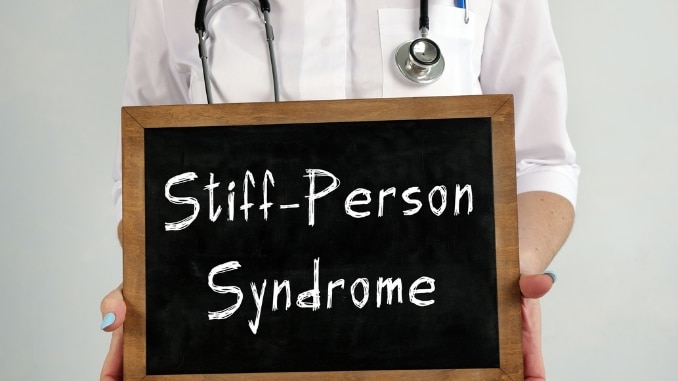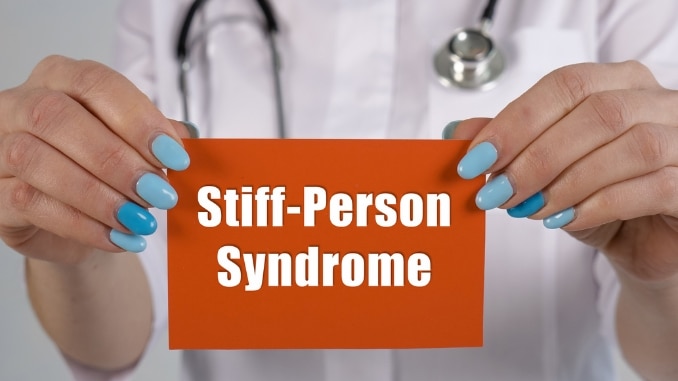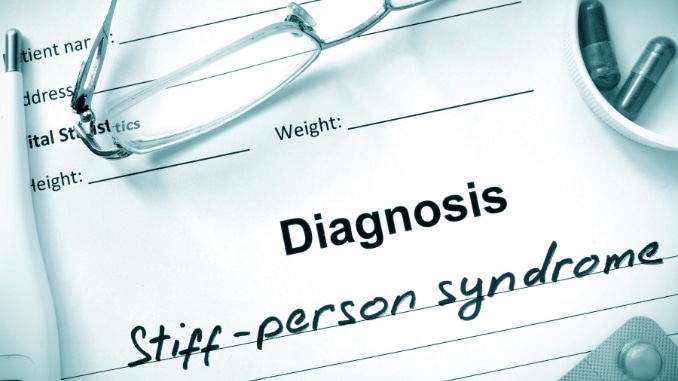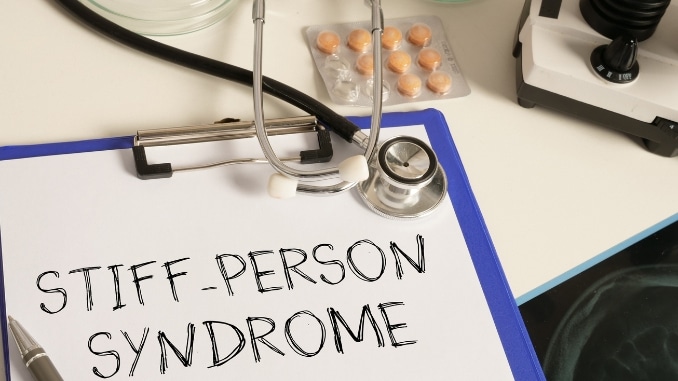
Stiff Person Syndrome (SPS) is a rare disease that makes the muscles in the back and legs tight and stiff, causing painful cramps. Because it’s so uncommon, many doctors might only come across it once or twice, making it tough to diagnose.
Without treatment, stiff person syndrome [1] can get worse or can kill, leading to serious mobility issues and a lower quality of life. The lack of awareness can add to the uncertainty and anxiety for those living with it.
This article is here to shed light on SPS, helping people understand its symptoms and the importance of catching it early.
Living with Stiff Person Syndrome

Living with SPS means learning how it affects your brain and muscles, which helps you manage symptoms better. By knowing what triggers the condition, you can take steps to make daily life easier.
Managing SPS involves medical care, changes to your routine, and emotional support. Questions like “Can you hug someone with stiff person syndrome?” often arise, highlighting the importance of understanding physical limitations. Adjusting work and social activities, along with help from loved ones and doctors, is key.
What Exactly is SPS?

SPS is a rare disorder that causes muscles to become stiff and leads to painful spasms. It affects fewer than one in a million people and stiff person syndrome can get worse over time or can kill if it’s not treated. [2]
Stiff Person Syndrome (SPS) affects the central nervous system, causing muscle stiffness and spasms due to disruptions in how the brain controls muscle movement.
In an interview, Dr. Scott Newsome, a neurology professor, shared that Stiff Person Syndrome (SPS) is a rare condition linked to problems with the immune system.
He explained that in 80% of cases, people with SPS have antibodies that lower GABA—a chemical that calms the nervous system. Without enough GABA, muscles become overly active, causing spasms, stiffness, and severe disability.
Symptoms:
- Muscle stiffness, especially in the back and legs.
- Painful muscle spasms.
- In some cases, it may cause phobias (fears) due to brain changes.
What Causes Stiff Person Syndrome?

Stiff Person Syndrome [3] is believed to be an autoimmune disorder, where the body’s immune system mistakenly attacks its own cells.
Here’s a breakdown of the main causes:
- Immune System Attack: In SPS, the immune system targets proteins that control muscle movement, especially GAD (glutamic acid decarboxylase).
- Reduced GABA Levels: GAD helps produce GABA, a chemical that relaxes muscles. Low GABA levels lead to constant muscle stiffness and spasms.
- Related Autoimmune Diseases: Many people with SPS also have autoimmune conditions like type 1 diabetes or thyroid issues.
- Unknown Triggers: The exact cause of this immune response is unclear, likely a mix of genetics and environmental factors.
- Movement Issues: Muscle stiffness and spasms make simple actions like walking or standing hard, affecting daily life.
How to Get Diagnosed with SPS: Key Steps to Know

- Talk to Your Doctor: Share your symptoms, like muscle stiffness, spasms, or trouble walking, with your healthcare provider.
- Neurological Exam: A specialist may check muscle reflexes and movement patterns.
- Blood Tests: Testing for anti-GAD antibodies helps confirm the diagnosis.
- Electromyography (EMG): This test measures electrical activity in muscles to check for abnormal signals.
- Rule Out Other Conditions: Doctors may run additional tests to rule out other possible causes of your symptoms.
Types of Stiff Person Syndrome

1. Classic Stiff Person Syndrome
- Symptoms: This type of SPS causes muscle stiffness and painful spasms, mainly in the trunk and legs. It can make simple tasks like walking or bending really tough because of the rigid posture.
- Diagnosis: SPS is often linked to antibodies that target GAD, an enzyme that helps control muscle movement.
- Treatment: Medications like diazepam or baclofen help relax muscles, and some people benefit from treatments like steroids, plasmapheresis, or IVIG to manage symptoms.
2. Stiff Limb Syndrome (SLS)
- Symptoms: This subtype affects one or more limbs, often starting in one leg and gradually spreading. It leads to severe stiffness and may cause problems with walking or maintaining balance. Patients may require canes or walkers for assistance.
- Diagnosis: Similar to classic SPS, this form is often associated with GAD antibodies.
- Treatment: Similar therapies as classic SPS, with a focus on GABA-enhancing drugs and immunotherapies.
3. Paraneoplastic Stiff Person Syndrome:
- Symptoms: This form is related to cancer (commonly breast cancer) and causes stiffness in the trunk and limbs, similar to classic SPS. However, it typically appears before the cancer is diagnosed.
- Diagnosis: In this form, antibodies against another protein, amphiphysin, are often present instead of GAD antibodies.
- Treatment: Treatment typically involves addressing the underlying cancer (e.g., chemotherapy or surgery) in addition to the standard therapies for stiffness.
4. Progressive Encephalomyelitis with Rigidity and Myoclonus (PERM):
- Symptoms: PERM is a more severe form of SPS that involves the brainstem and spinal cord, leading to stiffness, spasms, and myoclonus (involuntary jerking movements). It may also involve breathing difficulties.
- Diagnosis: This subtype can involve antibodies against the glycine receptor, along with GAD antibodies.
- Treatment: Similar to other forms of SPS, with the addition of more aggressive immunotherapy due to the severity of symptoms.
Conclusion
Stiff Person Syndrome (SPS) can cause serious problems if not treated or worse can kill. While it’s not always deadly, the muscle stiffness can make breathing hard or lead to dangerous falls.
Living with SPS means getting diagnosed early and having the right treatment and support. This helps manage symptoms, keeps the condition from getting worse, and lowers the risk of complications. Understanding questions like “Can you hug someone with stiff person syndrome?” can also foster awareness and empathy, contributing to better support for those with the condition.
Here’s the exciting news… You have more control over your immune system than you think! Check out this 14-Day Immune Health Quick Start Program now!
Frequently Asked Questions
How long do people live with stiff person syndrome?
SPS is a chronic condition, and with proper medical care, people can live for many years. However, the quality of life can be significantly impacted depending on the severity of the symptoms and complications. In some cases, untreated stiff person syndrome may kill or may lead to severe disability.
Has anyone ever recovered from stiff person syndrome?
While a complete cure is rare, some individuals experience symptom improvement or remission with treatments like medications that enhance GABA function, immunotherapy, or physical therapy. The degree of recovery can vary greatly from person to person.
What happens if you hug someone with stiff person syndrome?
Physical touch, including hugs, can sometimes trigger muscle spasms or discomfort in individuals with SPS. Their muscles may become stiff or rigid in response to sudden stimuli. You can still hug the person with stiff person syndrome, but it’s important to approach with care and ask what they’re comfortable with.
Can you touch someone with stiff person syndrome?
Yes, it’s possible to touch someone with SPS, but gentle and mindful contact is recommended. Sudden or unexpected touches may trigger spasms or increase muscle stiffness due to heightened sensitivity. It’s always best to communicate with the person to ensure comfort.

